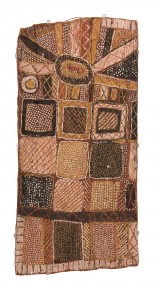Lot #38 - Artist Unknown
-
Auction House:Mossgreen
-
Sale Name:Australian Indigenous & Oceanic Art
-
Sale Date:21 Jul 2015 ~ 6.30pm
-
Lot #:38
-
Lot Description:Artist Unknown
(Bathurst or Melville Islands)
Untitled (Yirrikipayi) (1950s)
natural earth pigments on bark
85 x 39.7 cm -
Provenance:Private Collection; Aboriginal & Pacific Art, Sydney; Private Collection, Sydney
-
Notes:This superb but undocumented bark painting by an unknown Tiwi artist bears all the hallmarks of having been painted in the 1950s and has stylistic affinities with the painted bark baskets, tunga, collected in the field by C.P. Mountford in 1954 and published in The Tiwi: Their art, myth and ceremony, London: Phoenix House, 1958. The lower register of the composition features a grid of squares, some of which are concentric, decorated in patterns of red and white cross-hatching and white dotting, in a variety of combinations against red, yellow, black and white grounds. The irregular nature of the dotting suggests that these were not made in the traditional manner by means of a pwoja or wooden comb used for laying down lines of dots. The square design suggests the Tiwi symbols associated with Yirrikipayi the ancestral Crocodile. In the creation period Yirrikipayi was a man who lived in south west Bathurst Island. An expert spear maker, he was attacked by a group of Melville Islanders whose spears landed in his back; Yirrikipayi pulled out the spears, dived into the water to avoid his attackers and transformed into the Crocodile. The ridges of scales along his back are likened to Tiwi spearheads, and his tail is a bunch of spears he was carrying (Isaacs, J., Tiwi: Art, History, Culture, The Miegunyah Press, Melbourne, 2012, p.27). The upper register of the composition features elements that may relate to Pukumani burial ceremonies: the X-form in a square is a symbol of a grave. The connection between Yirrikipayi and the Pukumani ceremony is expressed through Crocodile dances that may be performed by appropriate clan members in funeral ceremonies. For a painted tunga collected by Mountford, in the collection of the South Australian Museum, see Tjamalampua or Malumerinita, Wuriupa, the totem place of the Sun Woman, 1954, in Isaacs 2012:109, and a bark painting by Tjamalampuwa, Sun Woman in her hut, 1954, also in the South Australian Museum, illustrated in Sutton, P. (ed), Dreamings. The art of Aboriginal Australia, New York: Viking, Melbourne in association with The Asia Society Galleries, 1988, p.77, fig.121. See also carved bark paintings of Crocodile designs by Black Joe Wombadiemeri and Kumaturrupi in Isaacs 2012:130. Wally Caruana
-
Estimate:A$18,000 - 25,000
-
Realised Price:
-
Category:Art
This Sale has been held and this item is no longer available. Details are provided for information purposes only.













